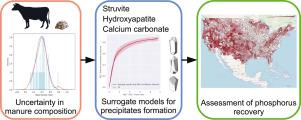Journal of Environmental Management ( IF 8.7 ) Pub Date : 2020-06-23 , DOI: 10.1016/j.jenvman.2020.110967 Edgar Martín-Hernández 1 , Gerardo J Ruiz-Mercado 2 , Mariano Martín 3

|
Nutrient pollution is one of the major worldwide water quality problems, resulting in environmental and public health issues. Agricultural activities are the main source of nutrient release emissions, and the livestock industry has been proven to be directly related to the presence of high concentrations of phosphorus in the soil, which potentially can reach waterbodies by runoff. To mitigate the phosphorus pollution of aquatic systems, the implementation of nutrient recovery processes allows the capture of phosphorus, preventing its release into the environment. Particularly, the use of struvite precipitation produces a phosphorus-based mineral that is easy to transport, enabling redistribution of phosphorus to deficient locations. However, livestock leachate presents some characteristics that hinder struvite precipitation, preventing extrapolation of the results obtained from wastewater studies to cattle waste. Consideration of these elements is essential to determine the optimal operating conditions for struvite formation, and for predicting the amount of struvite recovered. In this work, a detailed thermodynamic model for precipitates formation from cattle waste is used to develop surrogate models to predict the formation of struvite and calcium precipitates from cattle waste. The variability in the organic waste composition, and how it affects the production of struvite, is captured through a probability framework based on the Monte Carlo method embedded in the model. Consistent with the developed surrogate models, the potential of struvite production to reduce the phosphorus releases from the cattle industry to watersheds in the United States has been assessed. Also, the more vulnerable locations to nutrient pollution were determined using the techno-ecological synergy sustainability metric (TES) by evaluating the spatial distribution and balance of phosphorus from agricultural activities. Although only struvite formation from cattle operations is considered, reductions between 22% and 36% of the total phosphorus releases from the agricultural sector, including manure releases and fertilizer application, can be achieved.
中文翻译:

用于鸟粪石生产的牲畜渗滤液养分回收的模型驱动空间评估。
营养物污染是世界范围内主要的水质问题之一,导致环境和公共健康问题。农业活动是养分释放排放的主要来源,畜牧业已被证明与土壤中高浓度磷的存在直接相关,磷可能通过径流到达水体。为了减轻水生系统的磷污染,实施养分回收过程可以捕获磷,防止其释放到环境中。特别是,鸟粪石沉淀的使用产生了一种易于运输的磷基矿物,能够将磷重新分配到不足的地方。然而,牲畜渗滤液呈现出一些阻碍鸟粪石沉淀的特征,防止将废水研究的结果外推到牛粪。考虑这些因素对于确定鸟粪石形成的最佳操作条件以及预测鸟粪石的回收量至关重要。在这项工作中,牛粪沉淀物形成的详细热力学模型用于开发替代模型,以预测牛粪中鸟粪石和钙沉淀物的形成。有机废物成分的可变性以及它如何影响鸟粪石的生产,是通过基于嵌入模型的蒙特卡罗方法的概率框架来捕获的。与开发的替代模型一致,鸟粪石生产在减少美国养牛业向流域释放磷的潜力已经过评估。此外,通过评估农业活动中磷的空间分布和平衡,使用技术生态协同可持续性指标 (TES) 确定了更易受营养物污染的位置。尽管只考虑了牛场中鸟粪石的形成,但可以实现农业部门磷释放总量的 22% 至 36% 的减少,包括粪便释放和施肥。



























 京公网安备 11010802027423号
京公网安备 11010802027423号